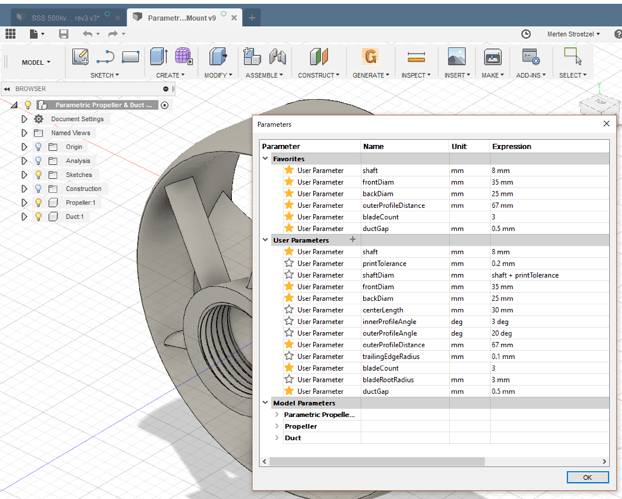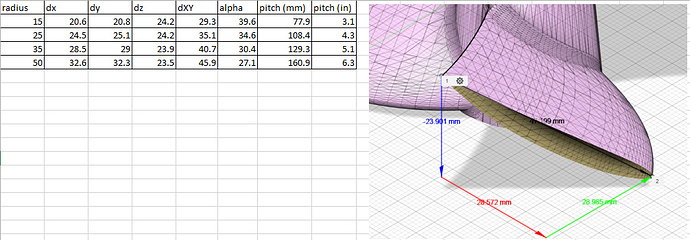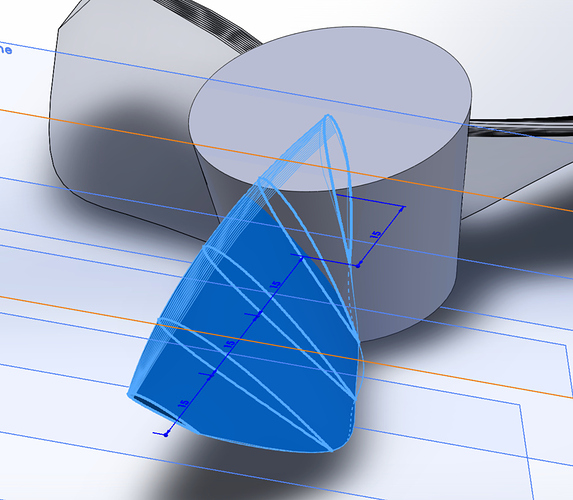You need .f3d file. I just tried the link at the very top and it works.
You saved my day. I faught with this one for quite a while. /Thanks
Greetings from north western Canada. I’m not current with CAD. I just downloaded a free version of Solidworks through the EAA educational program. It appears you can download a 30 day trial version of Fusion360 and then you have to pay after that?? Will Solidworks accept your wonderful Fusion360 files? Since I have not used the program yet, could one of you CAD experts separate theParametric Duct and the Prop so I can print them individually? Thanks for any help! and thank you Pacificmeister for all of the wonderful work you have done and your willingness to share it with everyone!!!
Cheers,
Phil Kite
Hi @PhilKite, you can export the Fusion models to many formats directly from web view in the browser, even without installing Fusion. And Fusion is free for students and educators, give it a try. Autodesk Education & Student Access | Autodesk
That is a great TIP!! I was in the local University in 1982 and it now looks like I’m back!! We used Autocad 2.1 back then and stored our files on 8" floppy disks. The computer to run Autocad was HUGE and took up a large part of a room.
Cheers,
Phil
@pacificmeister Hi!
I would like to adapt the Rev 3 of your duct to a larger prop like the one from flying rodeo for ex. I tried to download the .f3d of it to access have access to the parameters as on the Parametric Propeller & Duct.f3d (I understood that this was your base for the Rev 3), but I just get a fixed mesh being unable to modify anything.
Would you agree to post an original .f3d file of the Rev 3 of your duct with the parameters accessible?
Thanks!
Hi @Fabien_n, Rev3 references the parametric prop/duct linked in this thread above (I think). Here is again the direct Fusion link to this parametric prop/duct component: Fusion. Download the Fusion 360 Archive here:
…and import it into your Fusion project. You should be able to see the parameters:
Hope it works for you.
To reduce the drag, what do you think to change on the duct Naca 0012 by Naca 0010 ?
Do you think it is a good way ?
I would like to thank everyone for a great design in Fusion 360. I am new to the group. Is is possible to create a motor that works in opposite rotation from this design? I would like to make 2 smaller motors the rotate like they would for say a quad copter. Thanks for any help. This in itself is a great piece of design work.
I seem to be having issues with this breaking when outer diameter and other values are changed. Some error to do with references. Just trying to track down why, but perhaps some changes in Fusion360 were implemented since this was made. Is this currently working for others? If not, @Taylor would have time to have a quick look? This is an awesome asset!
My mistake guys. Seems to be okay now. Trying to see if I can make this work with a larger 65150 build but things need to be scaled up a fair bit. Unfortunately I’d have to scale up the base profiles and there’s no nice way to do that with tangent handles. So I’ll play around with that by eye and see what happens.
Hi @Taylor and @pacificmeister thanks very much for making this design available.
Here is my build using direct drive outrunner and adding a mount for the keel.
I’m interested to look at a design with more control of the angle of the attack of the blades along the radius of the blade.
I have done a sectional analysis of the pitch angle of the blades.
I assume you’d want to keep a constant pitch, ie:
pitch = radius * 2 * pi * tan (alpha)
For this prop the pitch varies quite significantly over the radius of the blade:
The @MaB prop is better, but still not perfect. As you can see it is pretty close to 8" pitch, however there is a +/- 10% variation in pitch along the radius of the blade, so it maybe possible to improve the efficiency of the prop?
My idea is that you can define several airfoil sections at different radii along the blade of the prop and loft the blade through each airfoil section, thus getting more precise control of the shape of the blade.
Something to test for the future.
I love the idea. Will try it !
Hi Mickey,
nice to see someone looking closer to the propeller shapes. I did some preparations to do a excel folder (VBA) to achieve parametric propeller design along the lines given by the definitions of the International Towing Tank Conference. I think you should define the blade sections along the respective imaginary cylinder shell - not along a straight cut. (see link below, page 53 ff)
https://ittc.info/media/7939/2017-ittc-dictionary.pdf
Another remark: it is not sure, that a constant pich propeller is the best solution in all circumstances. Propellers for boats and ships have often a different pitch near the root and the tip of the blades.
I had another idea in mind. Don’t know if it is valid. I was thinking that, independently of the pitch, constant Reynolds number from leading edge to trailing edge of airfoil section was important too. This would lead to chords decreasing toward the tips.
On most propellers chords of blade sections do decrease towards the tips. But the main reason is reducing the tip vortex. On ducted props there is no need to do this because the small gap between duct an tip oppresses most of the vortices (Kaplan propeller).
Hi Heimfriend, the nomenclature I used is probably not to best and can lead to confusion so I’ll clarify what I mean:
- Blade pitch (pitch angle) - the angle a certain chord section is relative to the plane of the disc of the propeller, this should decrease radially given the blade travels faster at the tip than the root
- Propeller pitch (geometric pitch) - the distance the propeller would travel forward in one rotation in an idealised medium. (ie a common prop size is 7x8" which means 7" diameter and 8" propeller pitch) My assumption is that this should be constant for any section of the blade
So to your comment - I agree that blade pitch should not be constant. But are you saying that the propeller pitch should not be constant under some circumstances?
Note there is also the constant pitch prop versus the variable pitch prop. The variable pitch prop refers to a different type of propeller where the blades of the prop are rotated to adjust the propeller pitch to suit the forward speed of the craft.






